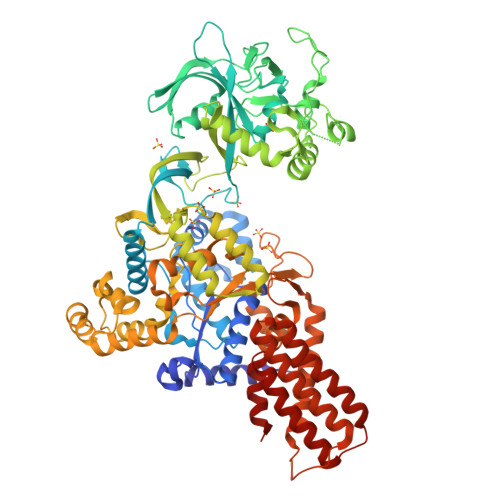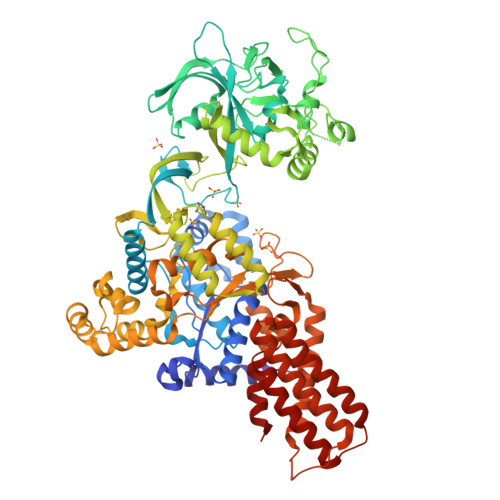Crystal Structure of Leucyl-tRNA Synthetase from the Archaeon Pyrococcus horikoshii Reveals a Novel Editing Domain Orientation
Fukunaga, R., Yokoyama, S.(2005) J Mol Biology 346: 57-71
- PubMed: 15663927
- DOI: https://doi.org/10.1016/j.jmb.2004.11.060
- Primary Citation of Related Structures:
1WKB - PubMed Abstract:
The editing domains of the closely homologous leucyl, isoleucyl, and valyl-tRNA synthetases (LeuRS, IleRS, and ValRS, respectively) contribute to accurate aminoacylation, by hydrolyzing misformed non-cognate aminoacyl-tRNAs. The editing domain is inserted at the same point of the sequence in IleRS, ValRS, and the archaeal/eukaryal LeuRS, but at a distinct point in the bacterial LeuRS. Here, we showed that LeuRS from the archaeon Pyrococcus horikoshii has editing activity against the nearly cognate isoleucine. The conserved Asp332 in the editing domain is crucial for this activity. A deletion mutant lacking the C-terminal region has only negligible aminoacylation activity, but retains the full activity of adenylate synthesis and editing. We determined the crystal structure of this editing-active, truncated form of P.horikoshii LeuRS at 2.1 A resolution. The structure revealed that it has a novel editing domain orientation. The editing domain of P.horikoshii LeuRS is rotated by approximately 180 degrees (rotational state II), with the two-beta-stranded linker untwisted by a half-turn, as compared to those in IleRS and ValRS (rotational state I). This editing domain rotational state in the archaeal LeuRS is similar to that in the bacterial LeuRS. However, because of the insertion point difference, the orientation of the editing domain relative to the enzyme core in the archaeal LeuRS differs completely from that in the bacterial LeuRS. An insertion region specific to the archaeal/eukaryal LeuRS editing domains interacts with the enzyme core and stabilizes the unique orientation. Thus, we established that there are three types of editing domain orientations relative to the enzyme core, depending on the combination of the editing domain insertion point (i or ii) and the rotational state (I or II): [i, I] for IleRS and ValRS, [ii, II] for the bacterial LeuRS, and now [i, II] for the archaeal/eukaryal LeuRS.
Organizational Affiliation:
Department of Biophysics and Biochemistry, Graduate School of Science, University of Tokyo, Japan.



















